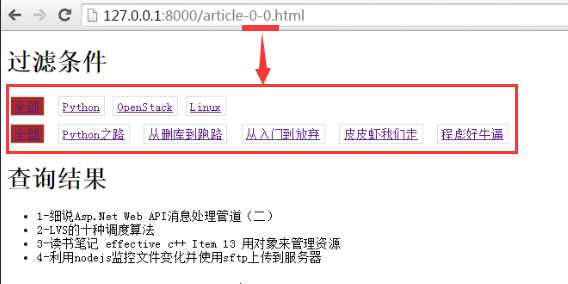标签:nal 基本原理 脚本 区分 相对 lte att 前端 splay
一、实现方法
二、基本原理
三、代码样例
方法1:纯模板语言实现
方法2:使用simpletag实现
四、其他变化
1.model定义
2.处理函数变化
3.simpletag相应改变
1.纯模板语言实现
2.自定义simpletag实现(本质是简化了纯模板语言的判断)
原理都是通过django路由系统,匹配url筛选条件,将筛选条件作为数据库查询结果,返回给前端。
例如:路由系统中的url格式是这样:
url(r‘^article-(?P<article_type_id>\d+)-(?P<category_id>\d+).html‘,views.filter)
其中article_type_id和category_id和数据库中字段是相对应的,此时当一个url为article-1-2.html时候,后台处理函数的参数将是一个字典{‘article_type_id‘: 1, ‘category_id‘: 1},然后将该条件作为数据库查询条件,最后得出结果返回给前端
urls.py
#!/usr/bin/env python3 # -*- coding: utf-8 -*- from django.conf.urls import url from . import views urlpatterns = [ url(r‘^$‘,views.index), url(r‘^article-(?P<article_type_id>\d+)-(?P<category_id>\d+).html‘,views.filter), ]
models.py
from django.db import models class Category(models.Model): caption=models.CharField(max_length=64) class Article_type(models.Model): caption=models.CharField(max_length=64) class Article(models.Model): title=models.CharField(max_length=64) content=models.CharField(max_length=256) category=models.ForeignKey(to=‘Category‘) article_type=models.ForeignKey(to=‘Article_type‘
views.py
def filter(request,*args,**kwargs): if request.method=="GET": condition={} for k,v in kwargs.items(): kwargs[k]=int(v) #模板if判断row.id是数字,所以这里需要转换 if v=="0": #当条件为0代表所选的是全部,那么就不必要加入到过滤条件中 pass else: condition[k]=int(v) aritcle=models.Article.objects.filter(**condition) aritcle_type=models.Article_type.objects.all() aritcle_category=models.Category.objects.all() return render(request,‘search.html‘,{ ‘aritcle‘:aritcle, ‘article_type‘:aritcle_type, ‘article_category‘:aritcle_category, ‘article_arg‘:kwargs, #将当前的筛选条件传递给html })
html模板
<!DOCTYPE html> <html lang="en"> <head> <meta charset="UTF-8"> <title>Title</title> <style> .container a{ display: inline-block; padding: 3px 5px; margin: 5px; border: 1px solid #dddddd ; } .active{ background-color: rebeccapurple; } </style> </head> <body> <h1>搜索条件</h1> <div class="container"> {% if article_arg.article_type_id == 0 %} <a class="active" href="/cmdb/article-0-{{ article_arg.category_id }}.html" rel="external nofollow" rel="external nofollow" rel="external nofollow" rel="external nofollow" >全部</a> {% else %} <a href="/cmdb/article-0-{{ article_arg.category_id }}.html" rel="external nofollow" rel="external nofollow" rel="external nofollow" rel="external nofollow" >全部</a> {% endif %} {% for row in article_type %} {% if row.id == article_arg.article_type_id %} <a class="active" href="/cmdb/article-{{ row.id }}-{{ article_arg.category_id }}.html" rel="external nofollow" rel="external nofollow" rel="external nofollow" rel="external nofollow" rel="external nofollow" rel="external nofollow" >{{ row.caption }}</a> {% else %} <a href="/cmdb/article-{{ row.id }}-{{ article_arg.category_id }}.html" rel="external nofollow" rel="external nofollow" rel="external nofollow" rel="external nofollow" rel="external nofollow" rel="external nofollow" >{{ row.caption }}</a> {% endif %} {% endfor %} </div> <div class="container"> {% if article_arg.category_id == 0 %} <a class="active" href="/cmdb/article-{{ article_arg.article_type_id }}-0.html" rel="external nofollow" rel="external nofollow" >全部</a> {% else %} <a href="/cmdb/article-{{ article_arg.article_type_id }}-0.html" rel="external nofollow" rel="external nofollow" >全部</a> {% endif %} {% for row in article_category %} {% if row.id == article_arg.category_id %} <a class="active" href="/cmdb/article-{{ article_arg.article_type_id }}-{{ row.id }}.html" rel="external nofollow" rel="external nofollow" rel="external nofollow" rel="external nofollow" >{{ row.caption }}</a> {% else %} <a href="/cmdb/article-{{ article_arg.article_type_id }}-{{ row.id }}.html" rel="external nofollow" rel="external nofollow" rel="external nofollow" rel="external nofollow" >{{ row.caption }}</a> {% endif %} {% endfor %} </div> <h1>查询结果</h1> <div> {% for row in aritcle %} <div>{{ row.id }}-{{ row.title }}</div> {% endfor %} </div> </body> </html>
定义simpletag
myfilter.py
#!/usr/bin/env python3 #_*_ coding:utf-8 _*_ #Author:wd from django import template from django.utils.safestring import mark_safe register=template.Library() @register.simple_tag def filter_all(article_arg,condition): ‘‘‘ 处理条件为全部 :param article_arg: 当前url字典:如{‘article_type_id‘: 1, ‘category_id‘: 1} :param condition: 要处理的条件,如article_type_id,用于区分当前处理选择了那个全部 :return: 返回下面页面形式 {% if article_arg.article_type_id == 0 %} <a class="active" href="/cmdb/article-0-{{ article_arg.category_id }}.html" rel="external nofollow" rel="external nofollow" rel="external nofollow" rel="external nofollow" >全部</a> {% else %} <a href="/cmdb/article-0-{{ article_arg.category_id }}.html" rel="external nofollow" rel="external nofollow" rel="external nofollow" rel="external nofollow" >全部</a> {% endif %} {% for row in article_type %} {% if row.id == article_arg.article_type_id %} <a class="active" href="/cmdb/article-{{ row.id }}-{{ article_arg.category_id }}.html" rel="external nofollow" rel="external nofollow" rel="external nofollow" rel="external nofollow" rel="external nofollow" rel="external nofollow" >{{ row.caption }}</a> {% else %} <a href="/cmdb/article-{{ row.id }}-{{ article_arg.category_id }}.html" rel="external nofollow" rel="external nofollow" rel="external nofollow" rel="external nofollow" rel="external nofollow" rel="external nofollow" >{{ row.caption }}</a> {% endif %} {% endfor %} ‘‘‘ if condition==‘article_type_id‘: if article_arg[condition]==0: print(article_arg[‘category_id‘]) res= ‘<a class ="active" href="/cmdb/article-0-%s.html" rel="external nofollow" rel="external nofollow" >全部</a>‘ % article_arg[‘category_id‘] else: res = ‘<a href="/cmdb/article-0-%s.html" rel="external nofollow" rel="external nofollow" >全部</a>‘ % article_arg[‘category_id‘] return mark_safe(res) elif condition==‘category_id‘: if article_arg[‘category_id‘]==0: res = ‘<a class ="active" href="/cmdb/article-%s-0.html" rel="external nofollow" rel="external nofollow" >全部</a>‘ % article_arg[‘article_type_id‘] else: res = ‘<a href="/cmdb/article-%s-0.html" rel="external nofollow" rel="external nofollow" >全部</a>‘ % article_arg[‘article_type_id‘] return mark_safe(res) @register.simple_tag def filter_type(article_type,article_arg): ‘‘‘ :param article_type: article_type对象 :param article_arg: 当前url字典 :return: {% for row in article_type %} {% if row.id == article_arg.article_type_id %} <a class="active" href="/cmdb/article-{{ row.id }}-{{ article_arg.category_id }}.html" rel="external nofollow" rel="external nofollow" rel="external nofollow" rel="external nofollow" rel="external nofollow" rel="external nofollow" >{{ row.caption }}</a> {% else %} <a href="/cmdb/article-{{ row.id }}-{{ article_arg.category_id }}.html" rel="external nofollow" rel="external nofollow" rel="external nofollow" rel="external nofollow" rel="external nofollow" rel="external nofollow" >{{ row.caption }}</a> {% endif %} {% endfor %} ‘‘‘ res=[] for row in article_type: if row.id== article_arg[‘article_type_id‘]: temp=‘<a class="active" href="/cmdb/article-%s-%s.html" rel="external nofollow" rel="external nofollow" rel="external nofollow" rel="external nofollow" >%s</a>‘ %(row.id,article_arg[‘category_id‘],row.caption) else: temp = ‘<a href="/cmdb/article-%s-%s.html" rel="external nofollow" rel="external nofollow" rel="external nofollow" rel="external nofollow" >%s</a>‘ % (row.id, article_arg[‘category_id‘],row.caption) res.append(temp) return mark_safe("".join(res)) @register.simple_tag def filter_category(article_category,article_arg): ‘‘‘ :param article_type: article_category对象 :param article_arg: 当前url字典 :return: {% for row in article_category %} {% if row.id == article_arg.category_id %} <a class="active" href="/cmdb/article-{{ article_arg.article_type_id }}-{{ row.id }}.html" rel="external nofollow" rel="external nofollow" rel="external nofollow" rel="external nofollow" >{{ row.caption }}</a> {% else %} <a href="/cmdb/article-{{ article_arg.article_type_id }}-{{ row.id }}.html" rel="external nofollow" rel="external nofollow" rel="external nofollow" rel="external nofollow" >{{ row.caption }}</a> {% endif %} {% endfor %} ‘‘‘ res=[] for row in article_category: if row.id== article_arg[‘category_id‘]: temp=‘<a class="active" href="/cmdb/article-%s-%s.html" rel="external nofollow" rel="external nofollow" rel="external nofollow" rel="external nofollow" >%s</a>‘ %(article_arg[‘article_type_id‘],row.id,row.caption) else: temp = ‘<a href="/cmdb/article-%s-%s.html" rel="external nofollow" rel="external nofollow" rel="external nofollow" rel="external nofollow" >%s</a>‘ % (article_arg[‘article_type_id‘],row.id,row.caption) res.append(temp) return mark_safe("".join(res))
html模板
{% load myfilter %}
<!DOCTYPE html>
<html lang="en">
<head>
<meta charset="UTF-8">
<title>Title</title>
<style>
.container a{
display: inline-block;
padding: 3px 5px;
margin: 5px;
border: 1px solid #dddddd ;
}
.active{
background-color: rebeccapurple;
}
</style>
</head>
<body>
<h1>搜索条件</h1>
<div class="container">
{% filter_all article_arg ‘article_type_id‘ %}
{% filter_type article_type article_arg %}
</div>
<div class="container">
{% filter_all article_arg ‘category_id‘ %}
{% filter_category article_category article_arg %}
</div>
<h1>查询结果</h1>
<div>
{% for row in aritcle %}
<div>{{ row.id }}-{{ row.title }}</div>
{% endfor %}
</div>
</body>
</html>
ps附上简图:

在如上的示例中,我们的过滤条件是从数据库中拿到,有时候我们定义的时候使用的是静态字段,此时组合搜索会稍微修改。
class Article(models.Model): title=models.CharField(max_length=64) content=models.CharField(max_length=256) category=models.ForeignKey(to=‘Category‘) article_type=( #使用静态字段放入内存 (1,‘linux‘), (2,‘python‘), (3,‘go‘), )
2.处理函数变化
###获取#### aritcle_type=models.Article.article_type#直接获取类的静态字段
3.simpletag相应改变
###由于我们传递的元祖,所以取值使用元祖方式 article_type[0]# 筛选条件id article_type[1]# 筛选条件名称
以上就是本文的全部内容,希望对大家的学习有所帮助,也希望大家多多支持脚本之家。
标签:nal 基本原理 脚本 区分 相对 lte att 前端 splay
原文地址:https://www.cnblogs.com/zheng-weimin/p/9538277.html